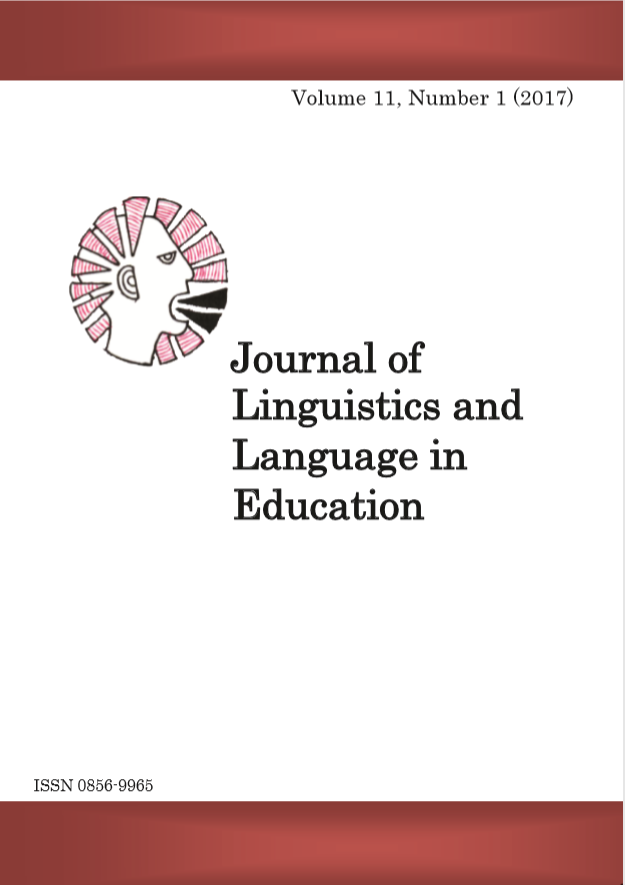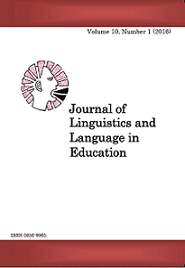Language Maintenance in the Face of Identity Shift €“ Some Insights from Ilorin, Nigeria
Abstract
This paper investigated the influence of politics on the linguistic and ethnic
identities of some Ilorin people of Yoruba ancestry and showed the variations
that exist in individuals ' degrees of allegiances to that ancestry. It paid
particular attention to ethnic converts; individuals who have crossed ethnic
boundaries while at the same time, maintaining linguistic allegiance to their
ancestral ethnicity. Survey and ethnographic methods were used. Proportional
sampling method was used for the selection of 100 questionnaire respondents
from the three local government areas constituting Ilorin. Structured
interviews which were conducted with 15 purposively selected respondents
with sufficient knowledge of their identities and community were
ethnographically analysed. A uniform pattern of linguistic identity was
established in favour of the Yoruba language but not so for the Yoruba ethnic
identity. A mosaic pattern of identity was established as 53.3% which
constitutes eight of the fifteen respondents, preferred a civic identity; 26.7% of
the respondents preferred their sole ancestral ethnic identity; Yoruba; two
respondents which constituted 13.3% of the respondents preferred hybrid
ethnic identities; Yoruba-Ilorin while there was also the case of an ethnic
converts who claimed non-ancestral ethnic belongingness (6.7%). Heritage
language maintenance did not translate into the maintenance of ancestral
ethnicity for a number of respondents as political allegiance was central to
their ethnic claims. Non-allegiance to an ancestry whose language is dominant
in Ilorin demonstrates that humans are not at the mercy of their heritage
languages even when such languages are the dominant medium of expression
for their community.
Key words: heritage language, ethnic identity, allegiance, belongingness
References
References
Baker, C. (2003). Foundations of Bilingual Education and
Bilingualism (3rd ed). Great Britain: Biddles Limited.
Bamgbose, A. (1991). Language and the Nation: The Language
Question in Sub-Saharan Africa. London: Edinburgh
University Press.
Danmole, H. O. (2012). Religion, Politics and the Economy in
Nineteenth Century Ilorin: Some Reflections. Ilorin: Unilorin
Press.
Deckert, S. K. & Vickers, C. H. (2011). An Introduction to
Sociolinguistics: Society and Identity. United Kingdom:
Continuum.
Yeseera Omonike Oloso|135
Edwards, J. (2009). Language and Identity: Key Topics in
Sociolinguistics. Cambridge: Cambridge University Press.
Ela, L. (1998a). Etno-a Sociolinguistika Situacijaserbsciny.
Najnowsze dzieje jezykow slowianskich. Serbscina. In H.
Faska et al. (eds.) Opole: Universytet Opolski: 43 €“57.
Elle, L. (1992b). Die Sorbische Sprache als Komponente der
Ethnizitat der Sorben. Letopis, 39(1): 123 €“27.
Federal Republic of Nigeria. (2009). Official Gazette, 96.
Fishman, J. A. (1998). Language and Ethnicity: The View from
within. The Handbook of Sociolinguistics. In F. Coulmas (ed.).
NJ: Wiley-Blackwell: 327 €“343.
Giles, H. (1973). Accent Mobility: A Model and some Data.
Anthropological Linguistics: 87 €“105.
Giles, H. & Coupland, N. (1991). Language: Contexts and
Consequences. Milton Keyness: Open University Press.
Giles, H., Bourhis, R. Y. & Taylor, D. M. (1977). Towards a Theory of
Language in Ethnic Group Relations. In H. Giles (ed.).
Language, Ethnicity and Intergroup Relations. London:
Academic Press: 307 €“348.
Giles, H., Mulac, A., Bradac, J. J. & Johnson, P. (1987). Speech
Accommodation Theory: The Next Decade and Beyond.
Communication Yearbook, 10. Newbury Park: Sage.
Glaser, K. (2007). Minority Languages and Cultural Diversity in
Europe. Gaelic and Sorbian Perspectives. England: Clevedon.
Hermon €“Hodge, H. O. (1929).Gazetteer of Ilorin Province. London:
George, Allen and Unwin.
Igboanusi, H. (2008). Mother Tongue-based Bilingual Education in
Nigeria: Attitudes and Practice. The International Journal of
Bilingual Education and Bilingualism. Philadelphia: Taylor
and Francis: 721 €“734.
Jacoby, S. & Ochs, E. (1995). Co-construction: An Introduction.
Research on Language and Social Interaction, 23(3): 171 €“183.
Jimoh, L. A. K. (1994). Ilorin: The Journey so far. Ilorin: Atoto Press
Limited.
Johnson, S. (1921). The History of the Yorubas. Cambridge:
Cambridge University Press.
Maalouf, A. (2000). On Identity. Translated from French by Barbara
Bray. London: The Harvill Press.
Nwagbo, O. G. (2014). Language and Identity in Oru Refugee Camp,
Ogun State, Nigeria. PhD. Thesis. Department of Linguistics
and African Languages. University of Ibadan.
| Language Maintenance
Oakes, L. (2001). Language and National Identity: Comparing
France and Sweden. U.S.A.: John Benjamin ' s Publishing
Company.
Omo-Ikokoro, A. (1911). Taalif Akhbar al-qurun min ' umara bilad
Ilurun.
Salihu, H. A. & Jawondo, A. I. (2006). Ilorin Emirate: Its People and
Politics. Ilorin: Centre of Learning. In S. A. Jimoh (ed.). Ilorin:
University of Ilorin Press: 1 €“16.
Woodbury, A. C. (1993). A Defence of the Proposition "when a
Language Dies, a Culture Dies". Proceedings of the First
Annual Symposium about Language and Society (SALSA).
Austin: Texas Linguistic Forum, 33
Downloads
Published
Issue
Section
License
Copyright © by Department of Foreign Languages and Linguistics, University of Dar es Salaam
All rights reserved. No part of this publication may be reproduced or transmitted in any form or by any means, electronic or mechanical, including photocopying, recording, or any information storage or retrieval system, without permission in writing from the publisher, except for short extracts in fair dealing, for research or private study, critical scholarly review or discourse with an acknowledgement.



